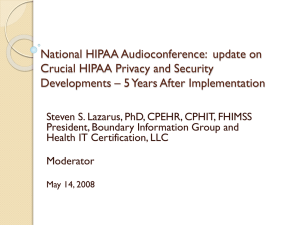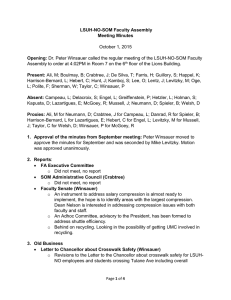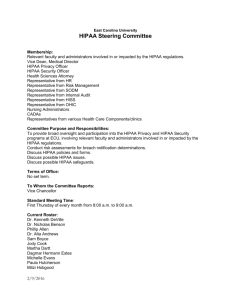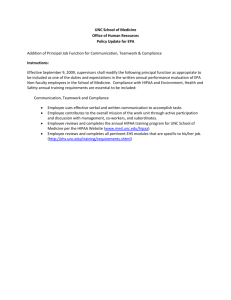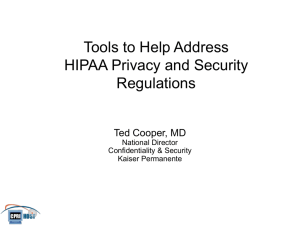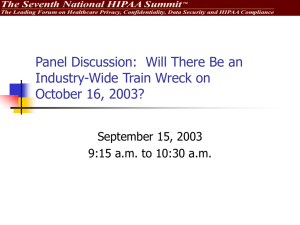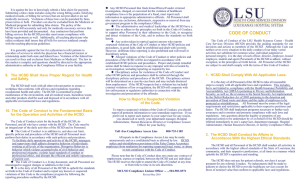How to Perform a Large Scale HIPAA Security Gap Analysis and as
advertisement
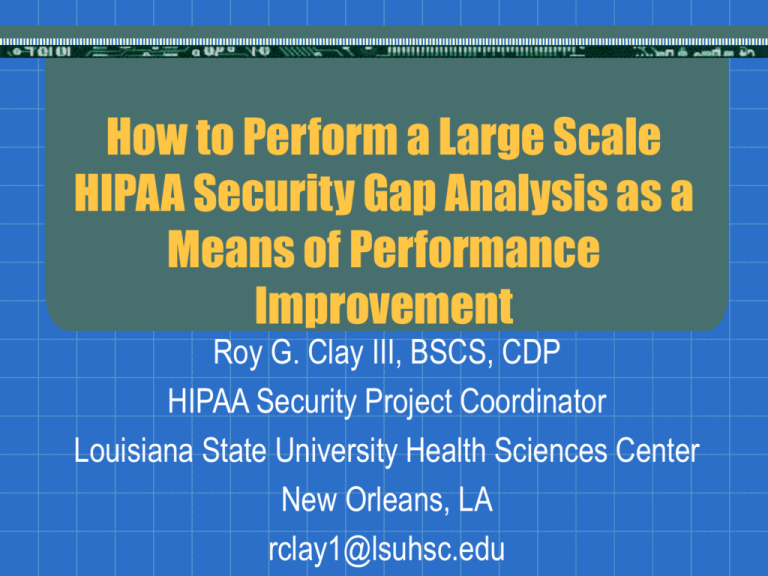
How to Perform a Large Scale HIPAA Security Gap Analysis as a Means of Performance Improvement Roy G. Clay III, BSCS, CDP HIPAA Security Project Coordinator Louisiana State University Health Sciences Center New Orleans, LA rclay1@lsuhsc.edu Louisiana State University A Hybrid Entity Covered Health Component Sciences Center Pennington Biomedical Research Center Definity Health Plan Non-Covered Agricultural Component & Mechanical College Law School Agricultural Center LSU at Eunice LSU at Alexandria LSU at Shreveport University of New Orleans LSU Health Sciences Center Vice President of Health Affairs Shreveport Campus University Hospital Schools of Medicine, GME Graduate Studies, Allied Health Health Care Services Division (HCSD) 9 Hospitals New Orleans Campus Medicine, Dentistry Nursing, Graduate Studies Allied Health 5000+ Health Care Services Division (Large Scale) Inpatient Admissions/mo. 30000+ Outpatient visits/mo. 600+ Deliveries/mo. 1,000,000 Lab tests/mo. 14,000 Prescriptions filled/mo. 3000+ Surgical Procedures/mo. 28000 ED visits/mo. 32,000+ Diagnostic Radiology procedures/mo. 2000+ Medical Staff members 10000+ Employees Challenges Large multi-entity organization. Distributed authority. Heterogeneous infrastructure. Budget. (What budget?) Poor organizational communication. Lack of computer literacy. Good practices in some areas but other areas overlooked. Little (if any) documentation. Gap Analysis Process Appoint Security Officer and Give Him the Authority to Perform the Gap Analysis. Iterative Discovery Process. Compile Results and Make Recommendations. Educate Your New Security Officer Security NPRM http://aspe.hhs.gov/admnsimp/bannerps.htm#security AAMC Guidelines http://www.aamc.org/members/gir/gasp/hipaaresources.htm WEDI SNIP Whitepapers http://snip.wedi.org/public/articles/index.cfm?Cat=17 Iterative Discovery Process Where is the data? Surveys. Interviews. Where is the Data? LSUHSC HCSD HIPAA Gap Analysis Project Application Administration August 8, 2001 LSUHSC Tulane Centrally Administered Systems Patient Management Windows NT Network LIS Academic Systems Hospital AdministeredSystems Vendor Administered Systems LSUHSC Clinics HL7 Interface Vendor Administered Systems Novell Network Department Administered Systems Medical Transcription New Pharmacy System Medical Records Storage Clearinghouse Vendor PACS/RMS Blue Cross Biomed Coding LHN Top Down Surveys Enterprise Level Site/Campus Level Application Level Interviews Five Targeted Groups Executive Staff (Including Medical) Human Resources Training Information Technology System Users Use responses from surveys to guide your interviews. Results and Recommendations Don’t wait to complete your surveys and interviews to begin compiling recommendations. Provide management with alternatives wherever possible. Make sure your recommendations are supported by your results. Remember Be prepared to go over things again and again. Plan for items to be late. Know how to escalate. Make every step educate as well as collect information. Caveat Emptor! “20% of HIPAA attorneys are passing incorrect information to their clients.” – Alan Mertz, Executive Vice-President, Healthcare Leadership Council HIPAA is new. Most of the consultants got to be experts on HIPAA by reading about it. Vendors probably know less about HIPAA Security than you do. Performance Improvement Security Management Process Policies, Standards, and Procedures (PSP Not P&P) Change Management Measurements Security Management Process Include other areas essential to the security process. (Facilities, Hospital Police, etc.) This group is the primary security policy making body. Recommends security projects to be included in overall project list. Policies, Standards, and Procedures Policies Standards Procedures Policies, Standards, and Procedures Policies are developed from the security management process. Policies should be simple and concise. Standards are set and revised by the appropriate group (usually IT) as specified in the policy. Procedures are developed to meet the requirements of policies and standards as needed. http://www.iso-17799.com/iso.htm Standards As few as possible but sufficient to cover all situations. Must be written. All projects, grants, construction, etc. must be checked for adherence to standards. Change Management Communications Tool. Automate workstation patches. Keep logbooks on servers. Use request form to initiate and track changes. Measurements Identify and track critical statistics. Make sure your measurements make sense from the users’ perspective. Scan your network. Finally Gap analysis provides a database than can be mined for performance improvement.
